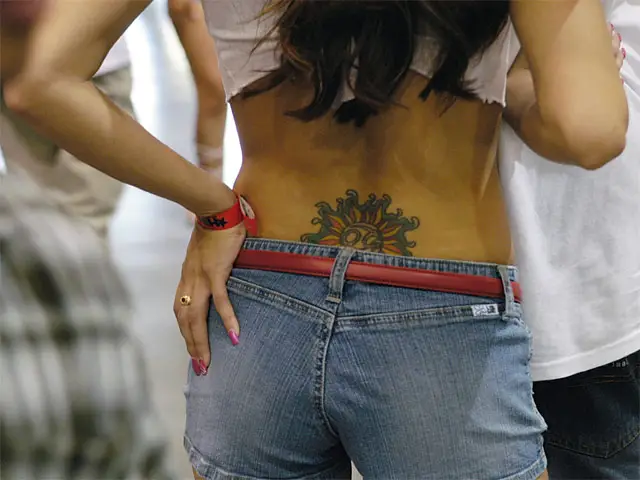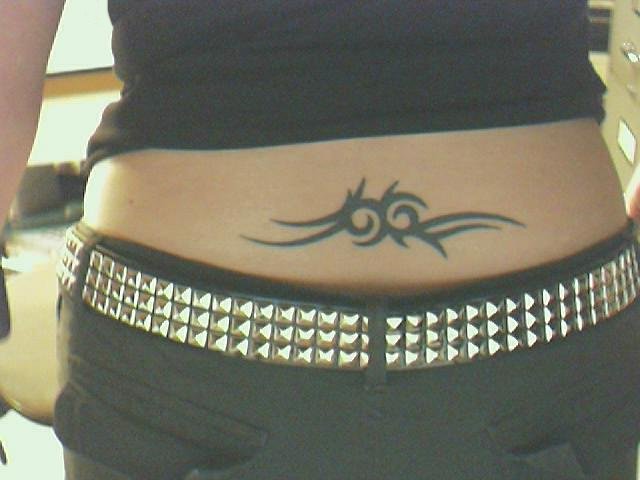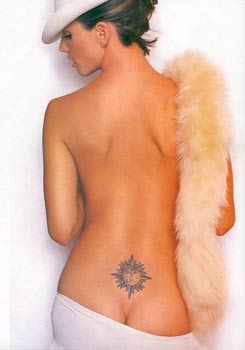In the last four to five years, the majority of American women who get a tattoo have been putting it in the same place: the small of their backs.
This type of tattoo is often referred to as a "bumper sticker," a "chick spot," a "girl spot," a "California license plate," or a "tramp stamp." The most popular designs for these tattoos are: butterflies, flowers, tribal designs and Chinese characters called kanji.
Tattoos are more prevalent now than they have been at any time in American history. An estimated 39 million or one out of every seven people in North America has at least one tattoo, according to en.Wikipedia.org. Once considered taboo because of their associations with criminality, tattoos have become a main stream trend.
Throughout history tattoos have had a myriad of meanings for various cultures. Some have had positive meaning and signified status and others had negative implications as they were used simply a means of identifying people.
Tattoos have signified social rank and rites of passage for Polynesians and for the Maori of New Zealand. Capitan James Cook's expedition to Tahiti in 1769 and subsequent South Pacific voyages in the 1770s made tattoos popular among European sailors. Wikipedia also states the word "tattoo" is traced back to the Tahitian word tatu or tatau, "meaning to mark or strike." Sailors had crucifixes tattooed on their backs to avert flogging as punishment.
Tattoos also indicated mob membership in the yazuka – the Japanese mafia and in the triad in Hong Kong. Phaseloop.com, a web site dedicated to human rights for foreign prisoners, states from the 1960s – 1980s, 20-30 million Russian prisoners used tattoos as statements against authority. Tattoos are still common in American prisons.
People have also been tattooed against their will. During the Holocaust the ka-tzetnik followed by a number was a means of identifying Jewish people in concentration camps.
 Tara Wolfstar, 43, a registered nurse and the master tattoo artist at Enchanted Ink in Boulder, Colorado, said she first saw the lower back tattoo emerge in the early nineties, and it has grown in popularity exponentially. The trend picked up in 2001 and is still going strong. Well over half of her clients want their tattoo placed on the small of their backs. Joe Martinez, 33, a tattooer at Bolder Ink, said that 70-80 percent of his female clients get their tattoo on their mid-lower back and attributes the location's popularity to the fashion of low-riding pants.
Tara Wolfstar, 43, a registered nurse and the master tattoo artist at Enchanted Ink in Boulder, Colorado, said she first saw the lower back tattoo emerge in the early nineties, and it has grown in popularity exponentially. The trend picked up in 2001 and is still going strong. Well over half of her clients want their tattoo placed on the small of their backs. Joe Martinez, 33, a tattooer at Bolder Ink, said that 70-80 percent of his female clients get their tattoo on their mid-lower back and attributes the location's popularity to the fashion of low-riding pants.
Today, the lower back tattoo often has personal significance to the recipient. Wolfstar added, a lot of women get a tattoo after a divorce; it can also be an age marker, among other symbols.
"It is art and it should have meaning. I know what it means…I could care less if someone judges or stereotypes me," said student Stephanie Shucard, 24, who recently had her lower back tattooed with the Celtic symbol for the rowan tree in honor of her 2 ½-year-old son, Rowan. The tattoo is an intricate design of interwoven branches with berries, representing the path of life. She suffered for her art; describing the tattooing sensation as feeling "like someone was taking a needle to a sunburn. When it hit the bone I got a buzzing sensation up to the top of my neck."
No anesthesia is used for the procedure since it constricts skin cells and prevents the ink from setting into skin. Martinez warned that torso areas are more painful than arms and legs. Wolfstar said when a woman ovulates it is difficult to get the ink into the skin, when she is menstruating the pain is more intense.
"If you have tattoos you have to be ready to hear people comment on them," said Grace Larson, 23, who has tolerated some tactless remarks. She went against the butterfly and flower tattoo majority by getting a traditional "Sailor Jerry" scull tattoo on her mid-lower back. Sailor Jerry tattoos are a set of designs created by sailor and tattoo artist Norman Collins, which were especially popular among American sailors during the 1940s. She likes the location of the tattoo because, "It's kind of in a discreet spot. You can see it if you bend over."
Shucard also said, "Girls consider it a sex symbol. It's considered more sexy to show more of your lower back."
Hidden or not, others such as librarian Jenny Gerke, 30, choose to keep their skin tattoo-free. Gerke said that she could never get a tattoo because, "Your tastes change over time. What seemed really cool to me at 18…it's not the same things that are cool to me at 30."
 Two men had mixed feelings on the trend. Film studies student Daniel Ellis, 27, said, "Body art can be rather tasteful and attractive regardless of placement," but added that in terms of a woman's physical appeal, "I think it detracts; in the vast majority of cases it's not attractive." Journalism graduate student Dana Query, 35, said, "I have seen some that I think are attractive, but generally I'm not too crazy about them. I've seen some that are too big or gaudy. It's just a total turn off."
Two men had mixed feelings on the trend. Film studies student Daniel Ellis, 27, said, "Body art can be rather tasteful and attractive regardless of placement," but added that in terms of a woman's physical appeal, "I think it detracts; in the vast majority of cases it's not attractive." Journalism graduate student Dana Query, 35, said, "I have seen some that I think are attractive, but generally I'm not too crazy about them. I've seen some that are too big or gaudy. It's just a total turn off."
The price of a bumper sticker tattoo ranges from $65 to $600 depending on the tattoo parlor, the size of the tattoo, and the amount of detail and color. Oftentimes tattoo subjects have to go for more than one sitting to have the detailing completed.
"It's a really stupid place to put a tattoo," said Wolfstar. She elaborated, saying that part of the body goes through changes with pregnancy and age. A woman's hips widen with pregnancy and with age it is common for fat to be deposited at the base of the spine. Over years of normal development, a bumper sticker tattoo could take on a different shape than the one intended by the artist and the client. "That's the thing working with a living canvas, it's all a crap shoot. I would definitely not put one there on myself."








